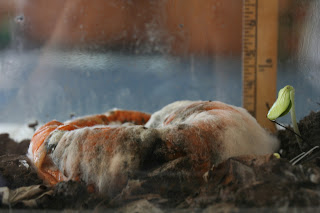When we came inside we started morning circle with “Silent
Greeting”, which is all about eye contact. The person doing the greeting finds
a person across the circle, meets their eyes, and does a motion. That person
greets them by doing the motion back. It was tricky, but we did it (almost)
silently!
We read the daily schedule and then shared home projects.
Teresa brought in an interesting curcubit: a warty gourd that was hollow, but
made a sound when shaken. We speculated that it was hollow because it had dried
out, but that the seeds were still inside making the sound. Another home
project was to be eaten: pumpkin chocolate cookies from Xav. Yum!
Next we read the morning message, which introduced today’s
theme, corn, and password. The password was “cereal” – and not the cereal you
eat for breakfast. We discussed how cereal crops are important grains that feed
people, such as corn, wheat, oats, and rye. We also mentioned how in England,
“corn” means wheat, in Scotland, “corn” means oats, and in America, “corn”
means maize! Wow. Corn has been important in the United States for thousands of
years. Unlike apples, corn has been here for a long time, and Native Americans
used it in many different ways.
Then it was time to meet our special guest for the day,
Maizie the corn snake. We talked about how her habitat is a field, or cornfield
and that’s why she is a corn snake. Also, the patterns on her belly look like
Indian corn. Homeschoolers had a chance to hold her and look closely at the
patterns on her body, which came in handy for our craft later. Maizie is always
a huge hit!


We had a snack of toasted corn snacks and then it was off to
Bramble Hill Farm to meet Farmer Hans. It was sunny and warm as we made our way
up the hill. John found a garter snake along the way.


We met Hans at McGregor’s Garden and he showed us the
popcorn corn stalks that were still standing. Kids looked for ears of corn
still on the stalk and found a few. The corn kernels were supposed to be small
and a deep maroon color, but some were cross-pollinated with a different
variety of corn a long way off, and so they were bigger and redder.
Hans discussed how Native Americans used the “three
sisters”: beans, corn, and squash many years ago. The corn provided a tall,
strong stalk for the beans to grow. The beans were nitrogen fixers, making the
soil fertile. And the squash grew large leaves over the soil, keeping it moist.
Hans had some beans growing with the corn and so we picked some for shelling.
Next Hans needed our help pulling the corn
stalks out of the ground. So we pulled them up and hauled them to the compost
pile. It was fun.




Then it was time to say goodbye to Hans, so we
headed back down the hill, checking for cattails, frogs and other goodies on
the way. John spotted a praying mantis egg sac!

At lunch we noticed how many people were “eating” our
passwords from homeschool. Everyone was eating some kind of cereal
grain, such as wheat, corn, and oats. Many of us had apples (pomology), and
other foods that were harvested, and grew with leaves containing chlorophyll.
After lunch we began our craft: making our own corn snakes!
Using Abenaki corn grown by Hans, homeschoolers created patterns with kernels
on their very own corn snakes. Some of us used the beans Hans gave us for
shelling.


At journal time we wrote about corn and glued some kernels
and art into our journals. Some kids described the decomposition of our pumpkin
from two weeks ago. (Look - some seeds sprouted!)

Then we read Weslandia, about a boy who creates his
own civilization based on one important crop he calls “swist”. Then we ate
popcorn from a cob, popped in an air popper. Delicious!
































No comments:
Post a Comment